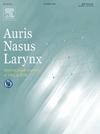Development of a vestibular implant for otolith stimulation: A mouse model study
IF 1.5
4区 医学
Q2 OTORHINOLARYNGOLOGY
引用次数: 0
Abstract
Objective
Worldwide, bilateral vestibulopathy (BVH) affects ≈1.8 million adults. Its symptoms include oscillopsia, postural instability, and gait disturbances, which significantly impair the patient’s quality of life. Despite advancements in vestibular rehabilitation, these approaches remain supportive and cannot restore vestibular function. We aimed to evaluate the efficacy of a vestibular implant targeting the utricle and saccule in a mouse model of BVH.
Methods
A total of 30 CBA/J mice underwent bilateral vestibular destruction, followed by implantation of a vestibular implant in the left ear. Of these, we selected 14 mice for analysis and divided them into three groups: no stimulation (vestibular destruction + implantation), 0.5V stimulation, and 1.0V stimulation groups. No intervention group was used as a control. Eye movement and behavioral analyses, including otolith-ocular reflex (OOR), vestibulo-ocular reflex (VOR), and gait assessments, were performed after 2 post-intervention weeks.
Results
Artificial vestibular stimulation significantly improved OOR responses, with 1.0V stimulation restoring vertical eye rotation angles to levels comparable to those in controls (p < 0.001). However, VOR gain remained impaired across all groups. Behavioral analysis revealed significantly reduced trunk deviation with 1.0V stimulation, with scores similar to those in the control group (p < 0.001). There was partial recovery of gait parameters, with stimulated groups showing a narrower base of support (p < 0.05); however, there was no significant improvement in stride length and speed.
Conclusion
Our findings indicated that targeted stimulation of the utricle and saccule via a vestibular implant can partially restore otolithic function, reduce trunk deviation, and improve gait stability in a mouse model of BVH. Despite the promising efficacy of chronic stimulation for functional recovery, it is important to further refine the stimulation parameters and electrode design, as well as determine the systemic effects. Our findings may inform the development of head-mounted vestibular prostheses for clinical application in patients with bilateral vestibular dysfunction.
用于耳石刺激的前庭植入物的开发:小鼠模型研究
目的在全球范围内,双侧前庭病变(BVH)影响约180万成年人。其症状包括示波器减退、姿势不稳和步态障碍,严重影响患者的生活质量。尽管在前庭康复方面取得了进展,但这些方法仍然是支持性的,不能恢复前庭功能。我们的目的是评估前庭植入物对BVH小鼠模型的脑室和球囊的疗效。方法对30只CBA/J小鼠进行双侧前庭破坏,然后在左耳植入前庭植入物。其中,我们选取14只小鼠进行分析,并将其分为无刺激(前庭破坏+植入)组、0.5V刺激组和1.0V刺激组。不设干预组作为对照。干预后2周进行眼动和行为分析,包括耳石-眼反射(OOR)、前庭-眼反射(VOR)和步态评估。结果人工前庭刺激可显著改善OOR反应,1.0V刺激可使眼垂直旋转角度恢复到与对照组相当的水平(p <;0.001)。然而,在所有组中,VOR增益仍然受损。行为分析显示1.0V刺激显著降低躯干偏差,得分与对照组相似(p <;0.001)。步态参数部分恢复,受刺激组的支撑基础变窄(p <;0.05);然而,在步幅和速度上没有明显的改善。结论通过前庭植入物靶向刺激耳室和小囊可部分恢复BVH小鼠耳石功能,减少躯干偏曲,改善步态稳定性。尽管慢性刺激对功能恢复有很好的疗效,但进一步完善刺激参数和电极设计以及确定全身效应是很重要的。我们的研究结果可能为双侧前庭功能障碍患者临床应用头戴式前庭假体的发展提供信息。
本文章由计算机程序翻译,如有差异,请以英文原文为准。
求助全文
约1分钟内获得全文
求助全文
来源期刊

Auris Nasus Larynx
医学-耳鼻喉科学
CiteScore
3.40
自引率
5.90%
发文量
169
审稿时长
30 days
期刊介绍:
The international journal Auris Nasus Larynx provides the opportunity for rapid, carefully reviewed publications concerning the fundamental and clinical aspects of otorhinolaryngology and related fields. This includes otology, neurotology, bronchoesophagology, laryngology, rhinology, allergology, head and neck medicine and oncologic surgery, maxillofacial and plastic surgery, audiology, speech science.
Original papers, short communications and original case reports can be submitted. Reviews on recent developments are invited regularly and Letters to the Editor commenting on papers or any aspect of Auris Nasus Larynx are welcomed.
Founded in 1973 and previously published by the Society for Promotion of International Otorhinolaryngology, the journal is now the official English-language journal of the Oto-Rhino-Laryngological Society of Japan, Inc. The aim of its new international Editorial Board is to make Auris Nasus Larynx an international forum for high quality research and clinical sciences.
 求助内容:
求助内容: 应助结果提醒方式:
应助结果提醒方式:


